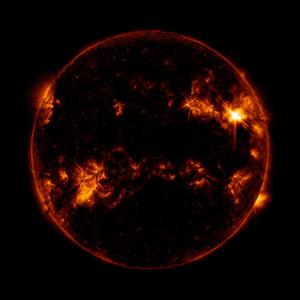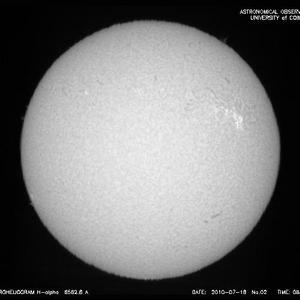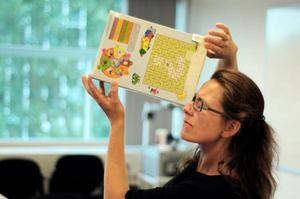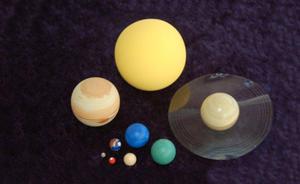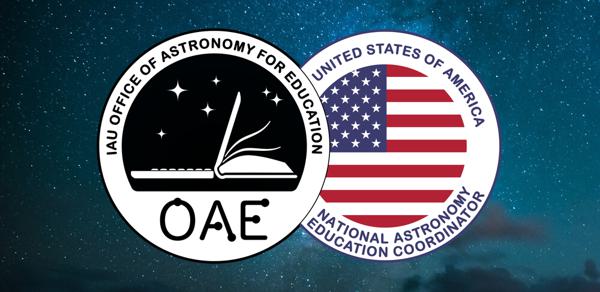Glossary term: 太阳
Description: 太阳是距离地球最近的恒星。对于天文学家来说,它是一颗 "G2V "型恒星。这意味着太阳是一颗主序星,典型温度("有效温度")为 5800 开尔文(K)。主序星是稳定的,其内核氢聚变释放的能量可以平衡引力产生的向内力。人眼看到的太阳是白色的,因为它发出大量可见光谱的光。当太阳位于天空较低的位置时,大气消光的增加会使太阳呈现黄色或橙色,因此太阳通常被描述为黄色。恒星的亮度从比太阳亮 1000 多倍到比太阳暗 1000 多倍不等,但更亮的恒星相对较少;太阳比银河系中的大多数恒星(可能约 85%)更亮(也更重)。
对于天文学家来说,太阳之所以有趣,是因为它距离我们很近,这意味着太阳表面可以被更细致地分辨出来,从而可以对太阳的结构和现象进行研究。例如,对与太阳磁场有关的太阳活动的详细研究可以包括:太阳黑子(较冷的区域)、耀斑(短暂的闪光),甚至日冕物质抛射(从太阳抛出的带电粒子)。物理学家还从太阳内核探测到被称为中微子的基本粒子;这是核聚变过程的直接证据。氦元素首次在太阳光谱中被探测到,因此被命名为 "氦",它来自希腊神话中的太阳神赫利俄斯(Helios)。
Related Terms:
See this term in other languages
Term and definition status: The original definition of this term in English have been approved by a research astronomer and a teacher The translation of this term and its definition is still awaiting approval
The OAE Multilingual Glossary is a project of the IAU Office of Astronomy for Education (OAE) in collaboration with the IAU Office of Astronomy Outreach (OAO). The terms and definitions were chosen, written and reviewed by a collective effort from the OAE, the OAE Centers and Nodes, the OAE National Astronomy Education Coordinators (NAECs) and other volunteers. You can find a full list of credits here. All glossary terms and their definitions are released under a Creative Commons CC BY-4.0 license and should be credited to "IAU OAE".
If you notice a factual or translation error in this glossary term or definition then please get in touch.
Related Media
冬季光环,作者为德国的托马斯·吉格尔
Credit: Thomas Gigl/IAU OAE
License: CC-BY-4.0 Creative Commons 署名 4.0 国际 (CC BY 4.0) icons
太阳黑子
Credit: NASA/SDO/HMI credit link
License: PD Public Domain icons
太阳耀斑
Credit: NASA/SDO credit link
License: PD Public Domain icons
Related Activities
Measure the Solar Diameter
astroEDU educational activity (links to astroEDU website) Description: Hands-on activity to measure the Sun by using household materials.
License: CC-BY-4.0 Creative Commons 署名 4.0 国际 (CC BY 4.0) icons
Tags:
Hands-on
, Scales
, Observing
, Measurement
Age Ranges:
12-14
, 14-16
, 16-19
, 19+
Education Level:
Middle School
Areas of Learning:
Social Research
Costs:
Low Cost
Group Size:
Group
Skills:
Communicating information
, Constructing explanations
, Using mathematics and computational thinking
Counting Sunspots
astroEDU educational activity (links to astroEDU website) Description: Counting the Sunspots using real solar images and data.
License: CC-BY-4.0 Creative Commons 署名 4.0 国际 (CC BY 4.0) icons
Tags:
Hands-on
, Sunspots
, Data analysis
Age Ranges:
16-19
Areas of Learning:
Observation based
Costs:
Low Cost
Duration:
1 hour
Group Size:
Group
Skills:
Analysing and interpreting data
, Constructing explanations
, Using mathematics and computational thinking
Meet Our Neighbours: Sun
astroEDU educational activity (links to astroEDU website) Description: Explore the tactile version of our star; the Sun with household materials.
License: CC-BY-4.0 Creative Commons 署名 4.0 国际 (CC BY 4.0) icons
Tags:
Hands-on
, Model
, Sunspots
, Visually Impaired
, Tactile
Age Ranges:
6-8
, 8-10
, 10-12
Education Level:
Middle School
, Primary
, Secondary
Areas of Learning:
Interactive Lecture
, Modelling
Costs:
Low Cost
Duration:
1 hour
Group Size:
Group
Skills:
Analysing and interpreting data
, Developing and using models
Build a Safe Sun Viewer
astroEDU educational activity (links to astroEDU website) Description: Build a safe Sun viewer using cheap household items and learn why it is dangerous to look directly at the Sun, even briefly.
License: CC-BY-4.0 Creative Commons 署名 4.0 国际 (CC BY 4.0) icons
Tags:
Hands-on
, Safety
Age Ranges:
6-8
, 8-10
, 10-12
Education Level:
Primary
, Secondary
Areas of Learning:
Modelling
, Observation based
Costs:
Low Cost
Group Size:
Group
Skills:
Planning and carrying out investigations
Solar System Model
astroEDU educational activity (links to astroEDU website) Description: Make a model of the Solar System planets using household materials.
License: CC-BY-4.0 Creative Commons 署名 4.0 国际 (CC BY 4.0) icons
Tags:
Hands-on
, Model
, Planets
Age Ranges:
4-6
, 6-8
, 8-10
Education Level:
Pre-school
, Primary
Areas of Learning:
Modelling
Costs:
Low Cost
Duration:
30 mins
Group Size:
Group
Skills:
Analysing and interpreting data
, Asking questions
, Communicating information
, Developing and using models


